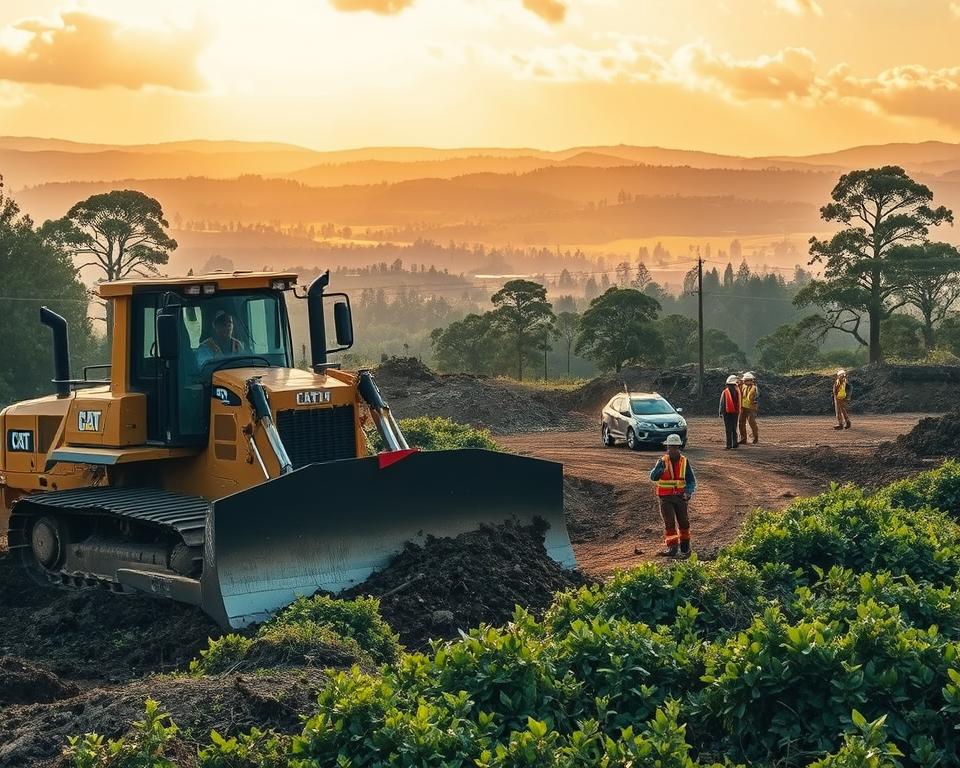Land Clearing Around Water Sources: Top Techniques
A little-known fact is that nearly seventy percent of the world’s fresh water reserves suffer threats from agricultural runoff and Land Clearing? This eye-opening figure calls attention to the critical need for responsible land management, essential during water source Land Clearing. Ensuring ecological accountability is key to upholding ecological balance and preserving aquatic purity and wildlife habitats. As communities face growing demands on resources, adopting sustainable land management practices is vital. It helps achieve project goals while preventing soil erosion and reducing pollution risks in aquatic ecosystems – land clearing services.
Key Conclusions
- Implementing sustainable land management is critical to shielding water quality.
- Implementing best practices can prevent soil erosion and habitat loss.
- Awareness of environmental impacts is critical for responsible Land Clearing.
- Proper planning enhances project success while safeguarding ecosystems.
- Utilizing effective techniques promotes biodiversity in aquatic landscapes.
Comprehending Sustainable Land Clearing’s Importance
Land Clearing involves more than simply uprooting vegetation. It has ecological effects of Land Clearing that can affect adjacent zones, particularly aquatic ones. Traditional methods often cause soil erosion, disrupt habitats, and can pollute water. Recognizing these impacts is essential for embracing superior land management.
Environmental Impacts of Standard Land Clearing
Typical Land Clearing practices can lead to various environmental challenges. Loss of vegetation results in soil erosion, soil degradation, and sediment runoff into aquatic systems. Such runoff contaminates water bodies, jeopardizing aquatic ecosystems. This process puts local wildlife at risk and disturbs ecosystem balance.
Eco-friendly Land Management Alternatives
Implementing sustainable land management practices mitigates problems of standard clearing. Selective clearing, where specific plants are removed, preserves ecosystem balance. Using erosion control measures, like cover crops, stabilizes soil and protects water quality. Emphasizing indigenous vegetation bolsters wildlife and fosters ecological well-being.
Top Best Practices for Land Clearing
Successful clearing projects hinge on a solid understanding of ecological factors. Assessing environmental objectives is essential to guarantee clearing efforts are sustainable and impactful. With defined objectives, landowners can make choices that align environmental protection with development priorities.

Evaluating Your Environmental Objectives
Before starting any clearing project, it’s essential to assess environmental goals. This involves evaluating the local ecosystem and how clearing might affect wildlife, soil, and water. Identifying personal objectives helps develop strategies that protect local habitats and watersheds.
Selecting the Optimal Time for Clearing
The scheduling of clearing activities influences success greatly. Clearing during winter or early spring—when soils are frozen—minimizes disturbance and erosion. Knowing when to avoid clearing can lead to healthier landscapes and lower environmental impact.
Evaluating Local Regulations and Permit Requirements
Compliance with local Land Clearing regulations is critical for any project’s success. Familiarity with permits sidesteps legal issues and fines. Checking ordinances around protected sites ensures compliance and avoids disasters.
Land Clearing Adjacent to Aquatic Points: Prime Methods
Clearing strategies around aquatic sources emphasize safeguarding sensitive zones and preserving ecological equilibrium. A detailed strategy includes locating sensitive zones and using proper erosion control techniques. These steps are critical for preserving biodiversity and maintaining water quality.
Pinpointing Critical Areas for Protection
Before clearing begins, identifying sensitive areas, such as wetlands and riparian buffers, is vital. These unique ecological zones play a vital role in filtering pollutants and providing habitat for various species. By accurately mapping these zones, land managers can plan protective strategies before and after clearing.
Applying Erosion Control Techniques
After identifying critical areas, using erosion control tactics prevents sediment from entering water bodies. Methods like silt fences, vegetative buffers, and cover cropping are key to preserving water purity. Integrating eco-friendly clearing with erosion management nurtures healthier aquatic environments. This ultimately benefits both the environment and local communities.
Comparing Mechanical and Manual Clearing
Choosing between mechanical and manual Land Clearing methods is critical. Each has its own set of advantages and disadvantages, affecting the environment and the clearing process’s efficiency. Grasping these distinctions aids landowners in choosing strategies that suit their land management objectives.
Pros and Cons of Mechanical Clearing
Using heavy machinery, mechanical clearing quickly removes trees, shrubs, and rubbish. It speeds project timelines and reduces manual labor requirements. However, heavy equipment may disturb soils, cause compaction, and harm ecosystems.
- Pros: Quick removal of extensive regions.
- Decreased labor requirements.
- Ability to handle tough terrain.
- Drawbacks: Greater ecological disturbance.
- Risk of soil erosion.
- Threat of habitat loss.
Manual vs Selective Clearing: Benefits
Manual and selective Land Clearing methods focus on ecological sustainability. They use skilled labor for targeted removal, minimizing soil disturbance and preserving plant species. This method is ideal when maintaining biodiversity and ecological health are key.
- Advantages: Preservation of native vegetation.
- Reduced soil disturbance and erosion.
- Enhanced habitat protection for wildlife.
Wetland Clearing Techniques
Wetland ecosystems are remarkable environments that play a vital role in maintaining ecological balance. They cleanse water, moderate floods, and support various plant and animal species. Comprehending wetland function underpins responsible clearing. The aim is to reduce disturbances and protect these crucial aquatic zones.
Comprehending Wetland Ecosystems
Wetlands feature specific hydrologic conditions, soils, and flora. They serve as transitional zones between terrestrial and aquatic environments, supporting a variety of wildlife. These ecosystems are essential for water quality regulation, providing natural filtration processes that remove pollutants. Preserving their integrity contributes to overall biodiversity and ecological resilience.
Responsible Wetland Clearing Methods
Careful planning and precise execution underpin responsible wetland clearing. Techniques that promote ecological sustainability can mitigate the negative impacts of Land Clearing. Commonly used strategies include:
- Staging Operations: Conduct clearing in phases to minimize ecological disruption, allowing time for wildlife to adapt.
- Selective Clearing: Remove only specific vegetation types, preserving critical species for habitat stability.
- Encouraging Regrowth: Introduce practices that encourage natural vegetation regrowth after clearing, maintaining ecosystem functions.
- Establishing Buffer Areas: Establish buffer areas around sensitive wetland sections to protect aquatic habitats from disturbances.
Using these methods guarantees that wetland clearing respects wetland functions and decreases habitat loss risk.
Riparian Reserve Protection Strategies
Riparian buffer zones are key to aquatic ecosystem health. Situated along watercourses, they serve as natural protective buffers. They safeguard water quality and enhance biodiversity. By adopting best practices, land managers can prevent erosion, protect wildlife habitats, and preserve waterway ecological integrity.
Role of Riparian Buffers in Aquatic Ecosystems
Riparian buffers are key to supporting aquatic ecosystems. They remove contaminants, reinforce banks, and host diverse species. They function as shields against anthropogenic disturbances in waterways. Preserving these zones boosts water quality and supports fish and aquatic life, enhancing ecosystem resilience.
Best Practices for Maintaining Riparian Zones
Key practices for riparian zone care include:
- Avoid construction within buffer strips to minimize disturbance.
- Use native vegetation to stabilize banks and prevent erosion.
- Establish a diverse plant community to enhance habitat complexity and support wildlife.
- Manage invasive species to protect native plants and maintain ecosystem stability.
- Regularly assess soil health and water quality to guide management efforts.
Importance of Aquatic Land Clearing Strategies
Aquatic clearing strategies help maintain ecosystem harmony and water quality. Effective water quality management during clearing reduces pollution risks and promotes sustainability. Such methods curb sediment runoff and bolster aquatic ecosystem health.
Assessing Water Quality and Sediment Management
Proper water quality control begins with evaluating local water systems. Land clearing near these areas must prevent sedimentation, which harms water quality and aquatic life. Key strategies include:
- Establishing buffer zones to filter pollutants
- Using sediment traps and barriers to minimize runoff
- Selecting clearing times to coincide with low water levels
These practices shield water quality and sustain ecosystem health. Residual vegetation aids in sediment control and nutrient cycling, leading to healthier waterways.
Aquatic Biodiversity Protection
Protecting biodiversity around water sources ensures ecosystem robustness. Aquatic land clearing should preserve native species, which are vital for these habitats. Practices to enhance biodiversity include:
- Conserving critical habitats during clearing processes
- Implementing phased clearing to allow wildlife adaptation
- Restoring natural vegetation post-clearing to enhance habitat
Using these approaches helps land managers cultivate biodiversity in aquatic zones. The result is healthier, more flexible ecosystems. Such efforts protect waterway health and support sustainable land-use practices.
Considerations for Stream Bank Clearing
Clearing stream banks poses unique challenges, requiring attention to ecological impacts and regulations. Respecting riverbank guidelines is vital to maintain water source ecosystem balance. Issues like erosion, habitat disruption, and water quality decline require strategic solutions during clearing.
Stream Bank Clearing Challenges
Stream bank clearing involves various challenges. Erosion is a chief issue, resulting in soil loss and impaired water quality. Habitat disruption endangers fauna dependent on riparian habitats. Without plants, stormwater runoff surges, depositing sediments in watercourses. Such problems underscore the importance of managing stream banks effectively.
Combatting Erosion and Promoting Healthy Flora
Mitigating erosion is key for stream bank clearing. Planting native species helps stabilize banks. Root systems reduce erosion, promoting a sustainable habitat for local plants and wildlife. Regular assessments during clearing ensure methods are effective, keeping riverbank considerations central to environmental care. Robust vegetation aids land management and preserves ecological integrity.
To Summarize
Following best practices in water source Land Clearing is critical to ecosystem well-being. Stakeholders must focus on sustainable land management. This approach not only fulfills their goals but also protects the environment. Thoughtful planning and execution guarantee that clearing preserves aquatic ecosystems and biodiversity.
Locating sensitive zones and applying erosion controls are fundamental steps. Using mechanical and manual methods enables landowners and contractors to practice responsible land management. Sustainable practices foster harmony between development and nature. This maintains vibrant, resilient water sources and adjoining landscapes.
The commitment to sustainable land management is a collective responsibility. Each clearing activity influences watershed health. By adopting eco-friendly methods, we enable a future where farming and environments thrive together.
